
Photo courtesy of Jan Marcus

On August 22, 2006, Jan Marcus contacted me with a brief message complimenting me on my website and providing a link to his own. On inspecting the "Tensegrities" page on his site, I found a tower of a design I had never seen before. (Jan's site is in Dutch, so I provide here an English translation of his "Tensegrities" page that he provided me with. At the end I also appended an example he gave me of using ANSYS to analyze a tensegrity prism.) On referring the link to the Geodesic listserv, Brian Hutchings came back with the observation that it "looks like a good example of 'aspension' -- iff the bottom cube is well-grounded."
Brian's observation struck me as a very apt characterization of the structure and helped me a lot to understand it. I had never seen aspension used in such a vertical way. Usually the structures which embody the technique, and here I include David Geiger's "cabledomes" and related structures, have very gradual slopes and are supported by non-tensegrity foundations at their perimeters. They don't seem like tensegrity domes to me so much as tensegrity roofs. But, to me, Jan's tower provides the "missing link" between self-sufficient floating-compression structures like those of Kenneth Snelson and the bicycle-wheel-like structures like Buckminster Fuller's aspension (Patent #3,139,957, 1964) and David Geiger's cabledome.
Jan also provided me with coordinate data for this structure, and so I am able to make it available for viewing in all the tensegrity viewers as "Aspension Tower (Marcus)". And here is a photo of one of the caps for his structure:
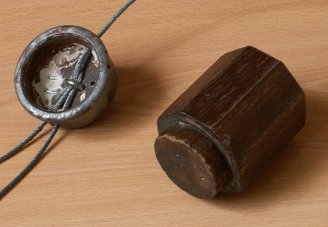
Aspension Tower: Cap
Photo courtesy of Jan Marcus
Below is a design of mine using this technology. I thought it was attractive, but the strut congestion is a problem and there is a frightful divergence of prestress in the structure with great amounts in the base and hardly any at the peak. Curiously, Jan's tower exhibits this same divergence although his mitigates it somewhat. This is curious to me because it is the reverse of what I would expect since Jan's tower is upside down compared to mine. I expected the stress concentrations to get swapped accordingly. I can see I have some things to learn about this structure. It would be nice to find a happy medium where the stresses are evened out across length of the tower.
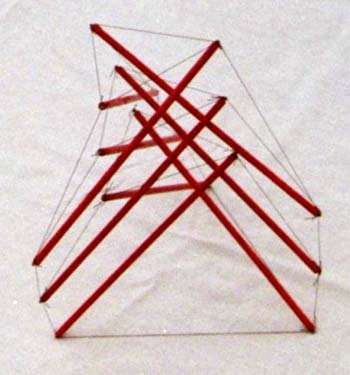 |
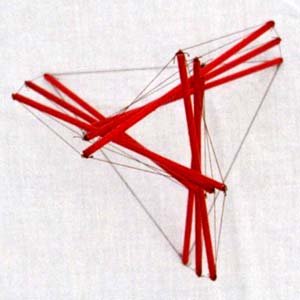 |
|
| Aspension Tower II | ||
I put together the datasheet for this structure on September 11, 2007. I assembled the model on September 17. It's my concept for a memorial for the September 11, 2001, disaster. Instead of the base tendons, I would fasten the three bottom struts to some sort of foundation. It is available for viewing in all the tensegrity viewers as "Aspension Tower II".
Email conversations in March, 2008, with Jan led me further consider his technology as well as my approach to tensegrity design using custom software as compared with his using ANSYS. I realize his structure is as much a revelation to me as René Motro et al.'s skew three-prism, and after consideration, I realized Skylon (constructed for the 1951 Festival of Britain) could be constructed in this manner so:
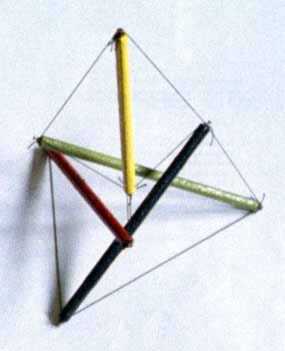
Aspension Skylon II
This seems to me the simplest structure realizable using Jan's technology, and pointed out to me as well that Skylon can be viewed as a precursor to Buckminster Fuller's aspension technology. On April 23, 2008, I put together a datasheet for an initial version of this structure which had equal-length tendons above and below supporting the central "skylon". I completed assembling a model on April 25.
Jan Marcus responded to my design by sending a version of this structure which had shorter tendons supporting the bottom of the "skylon" and longer ones supporting the top. I liked this better than my design, and actually Jan's version was closer to the appearance of the original Skylon. So I put together another datasheet that same day which had shorter tendons on the bottom. On April 28 I further revised the design so it tapered linearly, and on April 30 I assembled it. The result was used for the above photograph. Compared to other models I have assembled lately, both of these Skylon knock-offs were easy to put together. This last version is my proposal for a monument to love, truth and life. It is available for viewing in all the tensegrity viewers as "Aspension Skylon II".
On May 2, 2008, I put together a datasheet for a four-fold version. I assembled it on May 5. A photo is below.
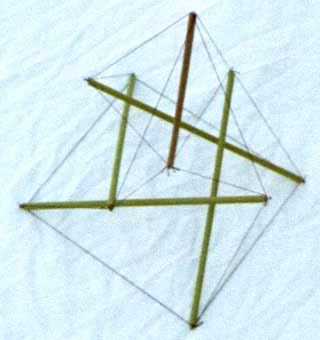
Four-fold Aspension Skylon
Its base is in the configuration of a half cuboctahedron. The stability of the four-fold version recommends itself to me. It won't tip over as easily as the three-fold version though with the tapering design, that one should be fairly stable as well.
In looking at making an arch based on this tower technology, I realized that Jan's technology does not yield structures with the end-to-end symmetry I am used to in other arches I have developed from towers. This is certainly not an obstacle to developing an arch based on an aspension tower, but certainly it seems worth exploring how the aspension technology can be extended to yield structures with end-to-end symmetry. My first experiment in this regard is the aspension canary below.
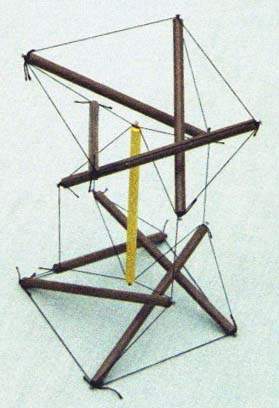
Aspension Canary
Now the ends of the tower are symmetrical with respect to each other. "canary" is an allusion to Rainer Werner Fassbinder's realization of Alfred Döblin's Berlin Alexanderplatz which has recently been restored (2006) and reissued (2007) on DVD. I have also created a datasheet for this structure. It is available for viewing in all the tensegrity viewers as "Aspension Canary".
I completed assembly of the model on May 20, 2008. It is remarkably torsion resistent, I mean for a prism, given its appearance. It feels like any other prism I have assembled. Of course they are a rather twisty breed. Below is a design (completed June 28, 2008) for an arch based on the aspension technology using a canary at the apex to unite a curved version of Jan's tower with its mirror image. The curve was generated by lengthening some tendons and struts (colored blue) and shortening some others (colored red). It is available for viewing in all the tensegrity viewers as "Aspension Arch".

Aspension Arch
During the summer of 2008, Jan presented a paper at the Bridges conference (Leeuwarden, Netherlands). His understanding of tensegrity and applying ANSYS to its design had obviously much advanced.


